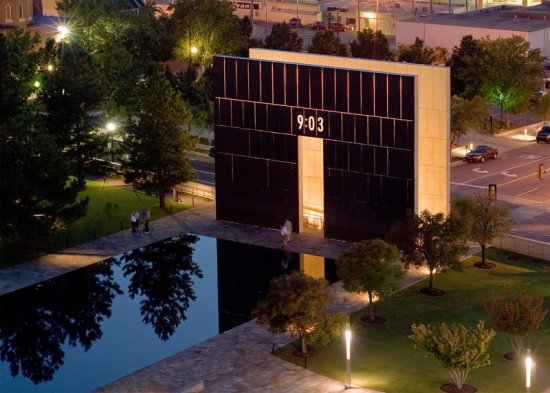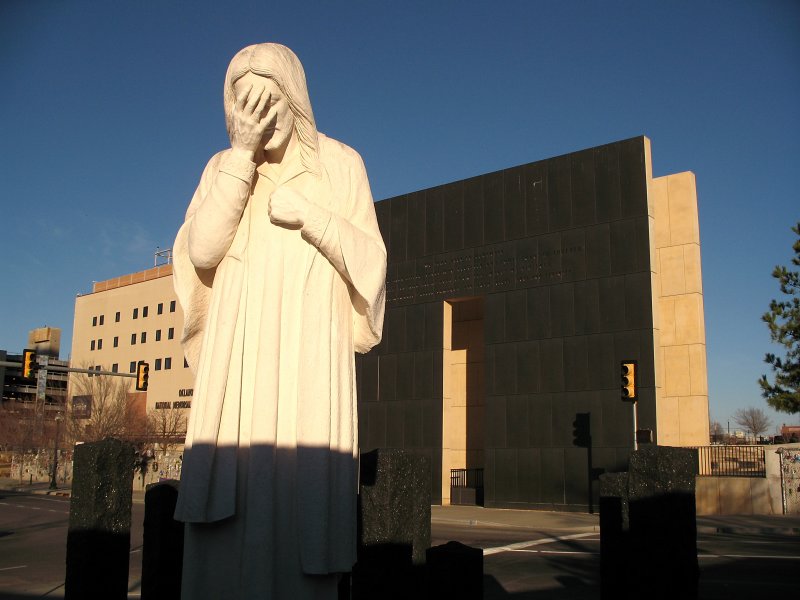Oklahoma City National Memorial features
Oklahoma City National Memorial features
The Outdoor Symbolic Memorial consists of the following segments on 3.3 acres (13,000 m²); it can be visited 24 hours a day, 365 days a year.
- The Gates of Time: Monumental twin bronze gates frame the moment of destruction – 9:02 – and mark the formal entrances to the Outdoor Memorial. 9:01, found on the eastern gate, represents the last moments of peace, while its opposite on the western gate, 9:03, represents the first moments of recovery. Both time stamps are inscribed on the interior of the monument, facing each other and the Reflecting Pool.
- The outside of each gate bears this inscription:
We come here to remember Those who were killed, those who survived and those changed forever. May all who leave here know the impact of violence. May this memorial offer comfort, strength, peace, hope and serenity.
- Reflecting Pool: A thin layer of water flows over polished black granite to form the pool, which runs east to west down the center of the Memorial (also see reflecting pool) on what was once Fifth Street. Visitors’ seeing their reflections are seeing “a face of a person changed by domestic terrorism.”
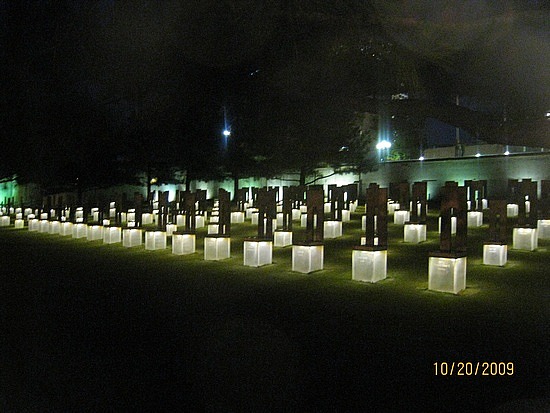 The Field of Empty Chairs, east Gate of Time, and Reflecting Pool at the Oklahoma City National Memorial.
The Field of Empty Chairs, east Gate of Time, and Reflecting Pool at the Oklahoma City National Memorial.
- Field of Empty Chairs: 168 empty chairs hand-crafted from glass, bronze, and stone represent those who lost their lives, with a name etched in the glass base of each. The chairs represent the empty chairs at the dinner tables of the victims’ families. The chairs are arranged in nine rows to symbolize the nine floors of the building; each person’s chair is on the row (or the floor) on which the person worked or was located when the bomb went off. The chairs are also grouped according to the blast pattern, with the most chairs nearest the most heavily damaged portion of the building. The westernmost column of five chairs represents the five people who died but were not in the Murrah Building (two in the Water Resources Board building, one in the Athenian Building, one outside near the building, and one rescuer). The 19 smaller chairs represent the children killed in the bombing. Three unborn children died along with their mothers, and they are listed on their mothers’ chairs beneath their mothers’ names.
- Survivors’ Wall: The only remaining original portions of the Murrah Building are the southeast corner, known as the Survivors’ Wall, and a portion of the south wall. The Survivors’ Wall includes several panels of granite salvaged from the Murrah Building itself, inscribed with the names of more than 800 survivors from the building and the surrounding area, many of whom were injured in the blast.
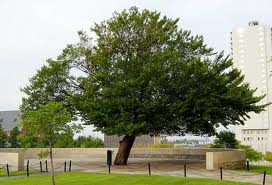
After surviving the bombing, The Survivor Tree elm became an emblem of the Memorial.
- The Survivor Tree: An American elm on the north side of the Memorial, this was the only shade tree in the parking lot across the street from the Murrah Building. Commuters arrived early to get one of the shady parking spots provided by its branches. Photos of Oklahoma City taken around the time of statehood (1907) show this tree, identifying it as at least 104 years old. The tree was taken for granted prior to the blast. Heavily damaged by the bomb, the tree survived after nearly being chopped down during the initial investigation, when workers wanted to recover evidence hanging in its branches and embedded in its bark.
The force of the blast ripped most of the branches from the Survivor Tree, glass and debris were embedded in its trunk and fire from the cars parked beneath it blackened what was left. Most thought the tree could not survive. Almost a year after the bombing, family members, survivors and rescue workers gathered for a memorial ceremony by the tree noticed it was beginning to bloom again. The Survivor Tree now thrives, as the Outdoor Memorial design included a mandate to feature and protect the Tree. For example, one of the roots that would have been cut by the wall surrounding the Tree was placed inside a large pipe, so it could reach the soil beyond the wall without being damaged. The decking around the Tree was raised several feet to make an underground crawlspace; workers enter through a secure hatchway and monitor the health of the Tree and maintain its very deep roots.
- The inscription around the inside of the deck wall around the Survivor Tree reads:
Hundreds of seeds from the Survivor Tree are planted annually and the resulting saplings are distributed each year on the anniversary of the bombing. Thousands of Survivor Trees are growing in public and private places all over the United States. The city sent saplings to Columbine High School after the massacre, toNew York City mayor Rudolph Giuliani after the September 11, 2001 attacks, and to Virginia Tech following its Virginia Tech massacre|massacre]] in 2007.
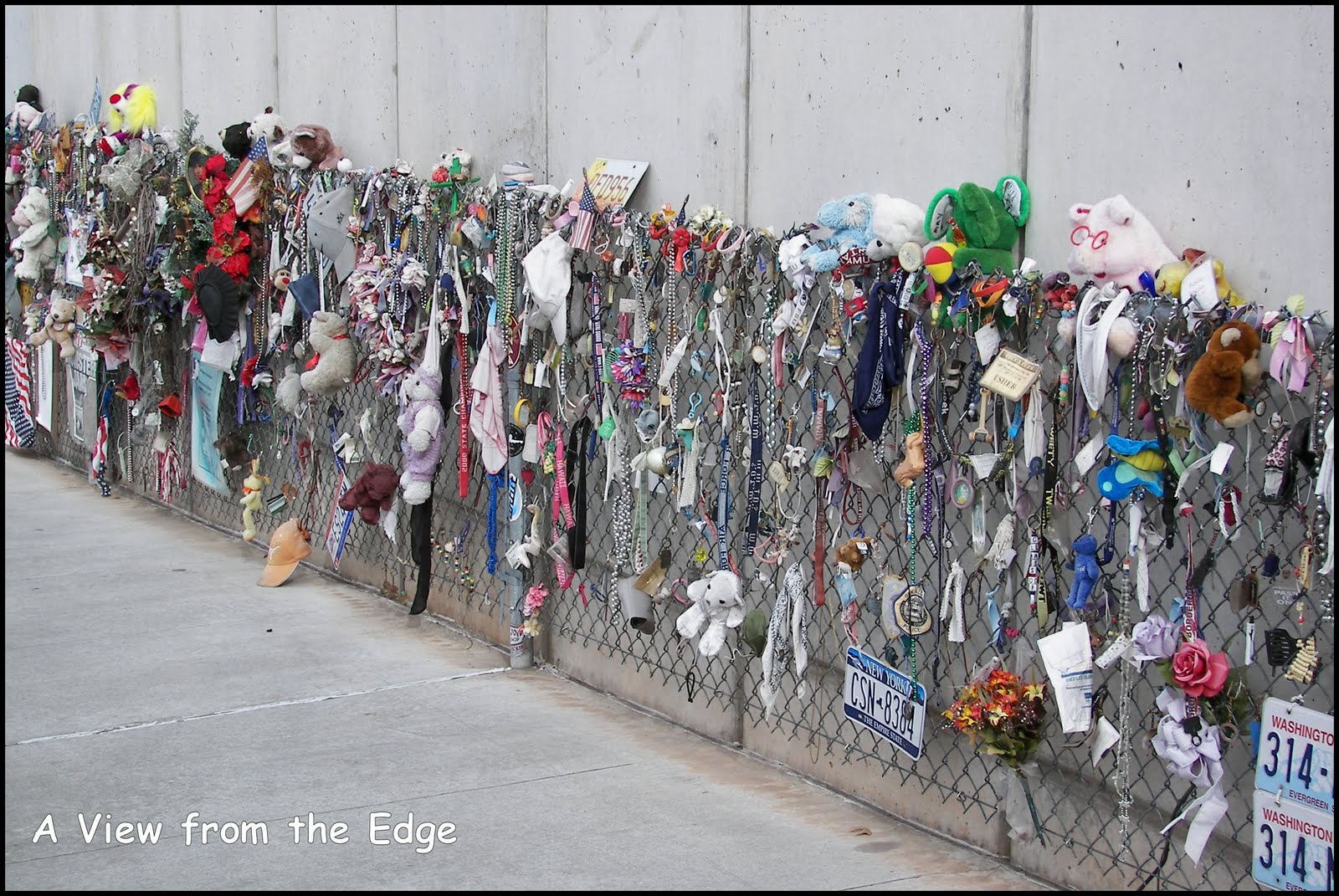
- The Memorial Fence: A 10-foot-tall (3.0 m) chain link fencewas installed around the area that is now the Reflecting Pool and the Field of Empty Chairs to protect the site from damage and visitors from injury. The Fence stood for more than four years, becoming notable as the place where visitors left stuffed animals, poems, keychains, and other items as tributes. During the construction of the Outdoor Memorial, 210 feet (64 m) of the Fence was moved to the west side of the Memorial, along the 9:03 side or the ‘healing’ side. The remainder of the Fence is in storage. Visitors may still leave small items along and in the Fence; the mementos are periodically collected, catalogued, and stored.
- Rescuers’ Orchard: A grove of Oklahoma redbuds (Oklahoma’s state tree), Amur Maple, Chinese Pistache, and Bosque Elmtrees are planted on the lawn around the Survivor Tree.
- Children’s Area: More than 5,000 hand-painted tiles, from all over the United States and Canada, were made by children and sent to Oklahoma City after the bombing in 1995. Most are stored in the Memorial’s Archives, and a sampling of tiles is on the wall in the Children’s Area. Chalkboards provide a place where children can draw and share their feelings. The Children’s Area is north of the 9:03 gate, on the west side of the Museum.
- And Jesus Wept: On a corner adjacent to the memorial is a sculpture of Jesus weeping, erected by St. Joseph’s Catholic Church. St. Joseph’s, one of the first brick-and-mortar churches built in the city, was almost destroyed by the blast. Not officially part of the memorial, the statue is regularly visited.
- Journal Record Building: North of the memorial is the Journal Record Building, which formerly housed the offices of the The Journal Record. It now houses the Oklahoma City National Memorial Museum, which features numerous exhibits and artifacts related to the Oklahoma City bombing. Staff of theNational Memorial Institute for the Prevention of Terrorism, a non-partisan think tank created shortly after the bombing by family members and survivors, also work here to spread knowledge of terrorism and its prevention.
- Alfred P. Murrah Federal Building Plaza: Located just south of the Field of Empty Chairs, above the underground parking garage, is the raised Alfred P. Murrah Federal Building Plaza. An original part of the federal building, the plaza had a garden and seating areas, as well as a playground for the daycare center. Visitors to the Memorial can walk across the plaza, where the original flagpole is used for the American flag.
